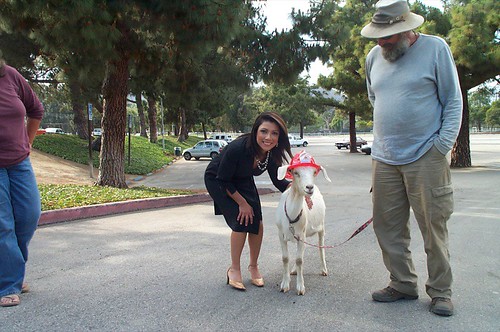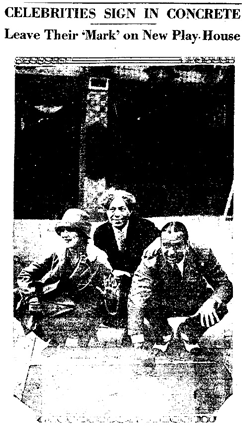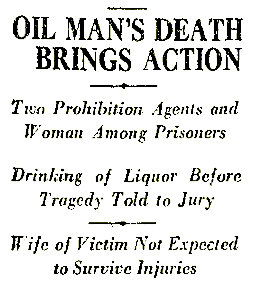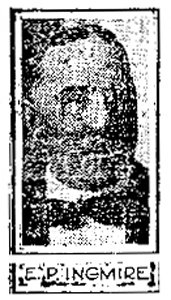Frankie the Fire Goat is on Myspace… be his friend?
Please click here to sign our petition demanding fire-fighting goats to protect our city! Please note, protest signatures will not appear or be counted. (Below, Channel 7’s Elsa Ramon with Frankie the Fire Goat)

To: City of LA/ L.A. Department of Recreation and Parks
The citizens of Los Angeles are deeply concerned after serious wildfires in the Griffith Park and Hollywood Hills have destroyed vast swaths of urban wilderness and killed or displaced thousands of animals during their breeding season.
These fires feed upon unchecked dry undergrowth, and endanger lives, homes, historic monuments and our enjoyment of the city. It will take decades before Griffith Park is restored to its pre-fire condition.
We the undersigned demand that the City of Los Angeles and the L.A. Department of Recreation and Parks respond to this continued threat by bringing in shepherds with herds of goats to graze on the dry hills, a plan previously implemented with great success by UC Berkeley in the aftermath of that community’s devastating 1991 fire.
Goats are economical, ecological fire-fighting machines that produce fertilizer as they clear hills and canyons of weeds, poison oak and dry chaparral. Additionally, the animals are charming, newsworthy ambassadors for fire safety, a subject that needs to be more widely discussed.
We want to save our parks and mountains. We want goats!
Sincerely,
Please click here to sign our petition demanding fire-fighting goats to protect our city! Please note, protest signatures will not appear or be counted.



 that the center of population is moving horribly, inexorably westward. Alfred T. Pelton, president of Interstate Mortgage and Investment Company, feels that Los Angeles’ extremely low density is sadly due to there being too many single family homes. As people bleed west into the Wilshire, Westlake and Hollywood districts, Pelton and his ilk are stirring up builders and investors to erect multifamily structures. While there is talk of Hollywood and Highland becoming a corner of note, we here at the Project know it will never displace Los Angeles’ top thriving business center–Brooklyn and Soto.
that the center of population is moving horribly, inexorably westward. Alfred T. Pelton, president of Interstate Mortgage and Investment Company, feels that Los Angeles’ extremely low density is sadly due to there being too many single family homes. As people bleed west into the Wilshire, Westlake and Hollywood districts, Pelton and his ilk are stirring up builders and investors to erect multifamily structures. While there is talk of Hollywood and Highland becoming a corner of note, we here at the Project know it will never displace Los Angeles’ top thriving business center–Brooklyn and Soto. 

 Normally, drunken vehicular homicides under the auspices of Volstead-Feds get swept under the rug, but unfortunately Ingmire was former president of the
Normally, drunken vehicular homicides under the auspices of Volstead-Feds get swept under the rug, but unfortunately Ingmire was former president of the 







